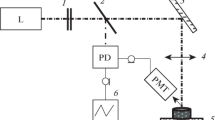Abstract
Numerical calculations using a model of unsteady combustion of melting energetic materials were performed to simulate the results of qualitative experiments on the ignition and quenching of energetic materials by a light pulse. The parameters of the model composition were chosen to correspond to combustion with the burning-rate control reaction in the gas phase to ensure the stability of self-sustained combustion after the cessation of irradiation. Regions of stable ignition in the coordinates “radiant flux amplitude-irradiation time” were obtained for compositions with different transparency for igniting pulses of three shapes: rectangular, linearly decreasing to zero, and exponentially decreasing. Extinction conditions of the steadily burning composition by a rectangular light pulse were calculated.
Similar content being viewed by others
References
V. F. Mikheev and Yu. V. Levashov, “Experimental Study of the Critical Conditions for Ignition and Combustion of Gunpowder,” Fiz. Goreniya Vzryva 9(4), 438–441 (1973) [Combust., Expl., Shock Waves 9 (4), 506–510 (1973)].
L. De Luca, L. H. Caveny, T. J. Ohlemiller, and M. Summerfield, “Radiative Ignition of Double Base Propellants: II. Preignition Events and Source Effects,” AIAA J. 14, 1111–1117 (1976).
M. Harayama, T. Saito, and A. Iwama, “Ignition of Composite Solid Propellant at Subatmospheric Pressures,” Combust. Flame 52, 81–89 (1983).
V. E. Zarko, “Ignition of Energetic Materials,” in Modelling and Performance Prediction in Rockets and Guns, Ed. by S. R. Chakravarthy and S. Krishnan (Chennai, Madras, India, 1998), Chapter 6, pp. 197–224.
V. E. Zarko, L. K. Gusachenko, and A. D. Rychkov, “The Effect of Phase Transitions on Combustion Stability of Melted Energetic Materials,” in Combustion and Detonation: Proc. of 28th Int. Annu. Conf. of ICT (Karlsruhe, FRG, 1997), pp. 16.1–16.13.
L. K. Gusachenko, V. E. Zarko, S. P. Ivaniya, and A. D. Rychkov, “Calculation of the Response of a Gasifying Energetic Material Exposed to Monochromatic Radiation,” Fiz. Goreniya Vzryva 47(1), 30–41 (2011) [Combust., Expl., Shock Waves 47 (1), 26–35 (2011)].
V. N. Simonenko, “Spectral transmittance of dibasic powders,” Fiz. Goreniya Vzryva 16(3), 141–142 (1980).
Ya. B. Zel’dovich, O. I. Leipunskii, and V. B. Librovich, Theory of Unsteady Combustion of Propellants (Nauka, Moscow, 1975) [in Russian].
B. V. Novozhilov, Unsteady Combustion of Solid Propellants (Nauka, Moscow, 1973) [in Russian].
A. A. Zenin, Processes in the Combustion Zones of Ballistite Powders (Atomizdat, Moscow, 1980) [in Russian].
L. K. Gusachenko and V. E. Zarko, “Combustion Models of Energetic Materials with Completely Gaseous Reaction Products,” Fiz. Goreniya Vzryva 41(1), (24–40) (2005) [Combust., Expl., Shock Waves 41 (1), 20–34 (2005)].
L. K. Gusachenko and V. E. Zarko, “Erosive Burning. Problems of Modeling,” Fiz. Goreniya Vzryva 43(3), (47–58) (2005) [Combust., Expl., Shock Waves 43 (3), 286–296 (2007)].
L. K. Gusachenko and V. E. Zarko “Analysis of Unsteady Solid Propellants Combustion Models (Review),” Fiz. Goreniya Vzryva 44(1), (35–48) (2008) [Combust., Expl., Shock Waves, 44 (1), 31–42 (2008)].
L. K. Gusachenko and V. E. Zarko, “Stability of Self-Sustained Combustion of Energetic Materials with Intense Subsurface Heat Release,” Khim. Fiz. 27(1), 91–99 (2008).
L. K. Gusachenko, E. B. Zarko, and D. Rychkov, “Instability of a Combustion Model with Surface Vaporization and Overheat in the Condensed Phase,” Fiz. Goreniya Vzryva 33(1), 43–51 (1997) [Combust., Expl., Shock Waves 33 (1), 34–40 (1997)].
M. V. Beckstead, “Condensed Phase Control? Or Gas Phase Control? ” Fiz. Goreniya Vzryva 43(2), 134–136 (2007) [Combust., Expl., Shock Waves 43 (2), 243–245 (2007)].
Author information
Authors and Affiliations
Corresponding author
Additional information
Original Russian Text © L.K. Gusachenko, V.E. Zarko, A.D. Rychkov.
__________
Translated from Fizika Goreniya i Vzryva, Vol. 48, No. 1, pp. 80–88, January–February, 2012.
Rights and permissions
About this article
Cite this article
Gusachenko, L.K., Zarko, V.E. & Rychkov, A.D. Ignition and extinction of homogeneous energetic materials by a light pulse. Combust Explos Shock Waves 48, 73–80 (2012). https://doi.org/10.1134/S0010508212010108
Received:
Published:
Issue Date:
DOI: https://doi.org/10.1134/S0010508212010108




